Related Research Articles
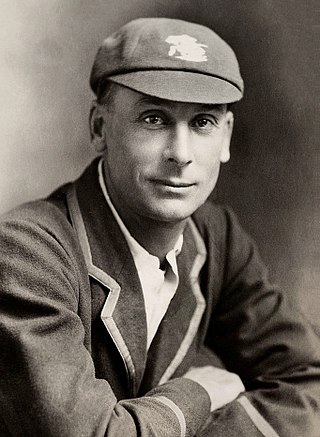
Sir John Berry Hobbs, always known as Jack Hobbs, was an English professional cricketer who played for Surrey from 1905 to 1934 and for England in 61 Test matches between 1908 and 1930. Known as "The Master", he is widely regarded as one of the greatest batsmen in the history of cricket. He is the leading run-scorer and century-maker in first-class cricket, with 61,237 runs and 197 centuries. A right-handed batsman and an occasional right-arm medium pace bowler, Hobbs also excelled as a fielder, particularly in the position of cover point. Hobbs was named as one of the five Wisden Cricketers of the Century alongside Sir Donald Bradman, Sir Garfield Sobers, Shane Warne, and Sir Viv Richards.
The Wisden Cricketers of the Year are cricketers selected for the honour by the annual publication Wisden Cricketers' Almanack, based primarily on their "influence on the previous English season". The award began in 1889 with the naming of "Six Great Bowlers of the Year", and continued with the naming of "Nine Great Batsmen of the Year" in 1890 and "6 Great Wicket-Keepers" in 1891.

Hedley Verity was a professional cricketer who played for Yorkshire and England between 1930 and 1939. A slow left-arm orthodox bowler, he took 1,956 wickets in first-class cricket at an average of 14.90 and 144 wickets in 40 Tests at an average of 24.37. Named as one of the Wisden Cricketers of the Year in 1932, he is regarded as one of the most effective slow left-arm bowlers to have played cricket. Never someone who spun the ball sharply, he achieved success through the accuracy of his bowling. On pitches which made batting difficult, particularly ones affected by rain, he could be almost impossible to bat against.

Sydney Francis Barnes was an English professional cricketer who is regarded as one of the greatest bowlers of all time. He was right-handed and bowled at a pace that varied from medium to fast-medium with the ability to make the ball both swing and break from off or leg. In Test cricket, Barnes played for England in 27 matches from 1901 to 1914, taking 189 wickets at 16.43, one of the lowest Test bowling averages ever achieved. In 1911–12, he helped England to win the Ashes when he took 34 wickets in the series against Australia. In 1913–14, his final Test series, he took a world record 49 wickets in a Test series, against South Africa.
Greville Thomas Scott Stevens was an English amateur cricketer who played for Middlesex, the University of Oxford and England. A leg-spin and googly bowler and attacking batsman, he captained England in one Test match, in South Africa in 1927. He was widely regarded as one of the leading amateur cricketers of his generation who, because of his commitments outside cricket, was unable to fulfil his potential and left the game early.

Arthur Percy Frank Chapman was an English cricketer who captained the England cricket team between 1926 and 1931. A left-handed batsman, he played 26 Test matches for England, captaining the side in 17 of those games. Chapman was appointed captain for the final, decisive Test of the 1926 series against Australia; under his captaincy, England defeated Australia to win the Ashes for the first time since 1912. An amateur cricketer, Chapman played Minor Counties cricket for Berkshire and first-class cricket for Cambridge University and Kent. Never a reliable batsman, Chapman nevertheless had a respectable batting record. He could score runs very quickly and was popular with spectators. As a fielder, contemporaries rated him extremely highly. Although opinions were divided on his tactical ability as a captain, most critics accepted he was an inspirational leader.
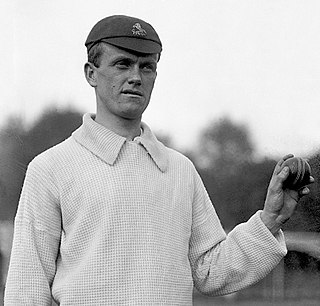
Colin Blythe, also known as Charlie Blythe, was an English professional cricketer who played Test cricket for the England cricket team during the early part of the 20th century. Blythe was a Wisden Cricketer of the Year in 1904 and took more than 2,500 first-class wickets over the course of his career, one of only 13 men to have done so.
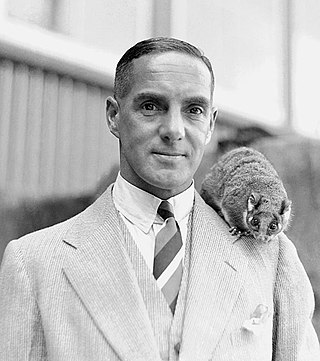
Herbert Sutcliffe was an English professional cricketer who represented Yorkshire and England as an opening batsman. Apart from one match in 1945, his first-class career spanned the period between the two world wars. His first-class debut was delayed by the First World War until 1919 and his career was effectively terminated in August 1939 when he was called up for military service in the imminent Second World War. He was the first cricketer to score 16 centuries in Test match cricket.He is most famous for being the partner of Jack Hobbs and the partnership between the two,Hobbs and Sutcliffe is widely regarded as the greatest partnership of all time.

Frank Edward Woolley was an English professional cricketer who played for Kent County Cricket Club between 1906 and 1938 and for the England cricket team. A genuine all-rounder, Woolley was a left-handed batsman and a left-arm bowler. He was an outstanding fielder close to the wicket and is the only non wicket-keeper to have held over 1,000 catches in a first-class career, whilst his total number of runs scored is the second highest of all time and his total number of wickets taken the 27th highest.

Roy Kilner was an English professional cricketer who played nine Test matches for England between 1924 and 1926. An all-rounder, he played for Yorkshire County Cricket Club between 1911 and 1927. In all first-class matches, he scored 14,707 runs at an average of 30.01 and took 1,003 wickets at an average of 18.45. Kilner scored 1,000 runs in a season ten times and took 100 wickets in a season five times. On four occasions, he completed the double: scoring 1,000 runs and taking 100 wickets in the same season, recognised as a sign of a quality all-rounder.
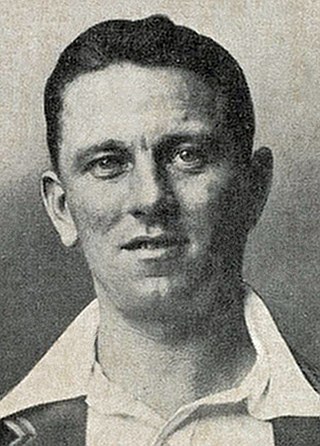
Maurice Leyland was an English international cricketer who played 41 Test matches between 1928 and 1938. In first-class cricket, he represented Yorkshire County Cricket Club between 1920 and 1946, scoring over 1,000 runs in 17 consecutive seasons. A left-handed middle-order batsman and occasional left-arm spinner, Leyland was a Wisden Cricketer of the Year in 1929.

Major William Booth was a cricketer who played for Yorkshire County Cricket Club between 1908 and 1914, a season in which he was named one of the Wisden Cricketers of the Year.

Harry Dean was an English cricketer who played for Lancashire and England.
Harold Thomas William Hardinge, known as Wally Hardinge, was an English professional sportsman who played both cricket and association football for England. His professional cricket career lasted from 1902 to 1933 during which he played first-class cricket for Kent County Cricket Club and made one Test match appearance for England. He was described as being "for years ... one of the leading opening batsmen in England".
John Thomas Newstead was an English first-class cricketer, who played 96 first-class matches for Yorkshire County Cricket Club between 1903 and 1913. An all-rounder who batted in the middle order, he was selected as one of Wisden Cricketers of the Year for 1909.
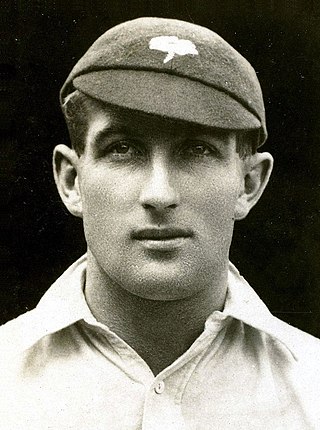
Abraham "Abe" Waddington, sometimes known as Abram Waddington, was a professional cricketer for Yorkshire, who played in two Test matches for England, both against Australia in 1920–21. Between 1919 and 1927 Waddington made 255 appearances for Yorkshire, and in all first-class cricket played 266 matches. In these games, he took a total of 852 wickets with his left arm fast-medium bowling. Capable of making the ball swing, Waddington was admired for the aesthetic quality of his bowling action. He was a hostile bowler who sometimes sledged opposing batsmen and questioned umpires' decisions, behaviour which was unusual during his playing days.

1919 was the 26th season of County Championship cricket in England and the first since 1914. The authorities had doubted if cricket would remain popular after a four-year break and the strain of war. It was decided that County Championship matches should be reduced from three days' duration to two, but cricket had not lost its popularity and the two-day experiment was a failure. Yorkshire finished the season as champions, topping the table by four percentage points. No Test cricket was played but an Australian Imperial Forces team toured England, playing matches from mid-May until mid-September. Andy Ducat, Patsy Hendren, Percy Holmes, Herbert Sutcliffe and Ernest Tyldesley were named in the 1920 edition of Wisden Cricketers' Almanack as the Five Cricketers of the Year for their 1919 performances.
All first-class cricket was cancelled in the 1940 to 1944 English cricket seasons because of the Second World War; no first-class matches were played in England after Friday, 1 September 1939 until Saturday, 19 May 1945.
Cricket in World War I was severely curtailed in all nations where first-class cricket was then played except India. In England, South Africa and the West Indies, first-class cricket was entirely abandoned for the whole of the war, whilst in Australia and New Zealand regular competitions were played for the 1914–15 season but first-class matches were afterwards abandoned. In South Africa, first-class cricket did not recommence until a series of matches against the Australian Imperial Forces cricket team in late 1919, and provincial cricket was not played until a one-off match between Transvaal and Natal in April 1920.
Percy Walter Vasey played first-class cricket in one match for Somerset in the 1913 season. In the 1900s, he had played Minor Counties cricket for Hertfordshire. He was born at Highbury, London and died at Upton Hellions, Crediton, Devon.